Wolf River Story
When apple experts and aficionados gather together and start talking about really large apples their conversations will invariably open with discussions about Wolf River, an enormous apple that can be a startling sight for the novice seeing one for the first time. Wolf River is truly one huge handful of an apple where 2-3 can be more than enough for a family’s apple pie!
Wolf River, with its mild, sweet flavor and ability to hold its shape when cooked, is indeed a wonderful pie apple but it really shines when turned into apple butter. Wolf River is a world-class apple butter apple and has long been cherished for the smooth, creamy apple butter it produces after hours of slow cooking. For generations families and friends and communities of apple lovers have gathered together in the fall to enjoy the friendship and camaraderie of making Wolf River apple butter. This timeless tradition typically takes place over the course of a full day where bushels of apples are cooked and simmered over an open fire with everyone taking their turn slowly stirring the bubbly, spicy, aromatic mixture in large copper kettles.
Wolf River is one of those old heritage apples with a long documented history that traces its beginnings from the shore of Lake Erie to its birthplace along the banks of the Wolf River near Fremont, Wisconsin. Around 1856 William Springer packed his family and possessions onto a wagon and began heading south from Canada to Wisconsin. Somewhere en route he stopped along the shores of Lake Erie and purchased a bushel of apples, believed to be Alexander, itself an old apple originating in Russia and imported into this country in the 1800’s. (It’s a remarkable fact that we even know which variety of apple Mr. Springer purchased on his journey to Wisconsin!) When he reached his destination in Wisconsin, he planted a handful of Alexander seeds along the banks of the Wolf River that ran through the middle of his new farm. From these chance seedlings arose one of America’s greatest apples, Wolf River. It’s ironic that Mr. Springer probably never saw any of the apples as it is believed he sold his farm to a Mr. Henry Riflen before it fruited!
Wolf River resembles Alexander but is much bigger and flatter with darker shading and more red surface stripes than its parent. An interesting thing about Wolf River is its occasional ability to reproduce itself true-to-variety from seed. This is a very uncommon trait as nearly all apple varieties are self-unfruitful; i.e., they are unable to self-pollinate to produce apples on their own. In order to produce fruit, their blossoms must be fertilized with the pollen of another separate variety. All the apples produced by the “mother tree” as a result of this cross-pollination will always be the same but the seeds of these fruits will be a genetic cross of both parent trees, the mother tree and the pollen-donating tree. These “hybrid” apple seeds are thus unable to grow into trees identical to the original mother tree, except in rare cases like Wolf River.
As you would expect, having originated and thrived in the bitter cold winters in Wisconsin, Wolf River is an extremely cold-hardy apple and one well-suited for raising in the coldest regions of the country. It also grows very well in the South and has always been a Southern favorite for cooking, baking and, of course apple butter making!
The superlatives of Wolf River are many. In addition to its adaptability and capacity to thrive in any soil or climatic conditions, it is more resistant to apple scab, cedar apple rust and fire blight than most apples. It is a very vigorous grower and tends to have a spreading growth habit. It can sometimes be biennial in fruit production although it seems to produce some quantity of fruit most every year.
If you want to see one of Nature’s more inspired creations, take a look at a Wolf River tree hanging heavy with huge, one-pound fruits! It is truly a stunning sight you will not soon forget!



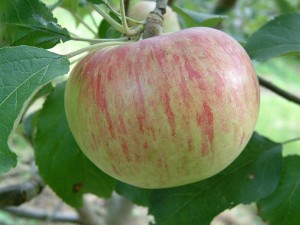
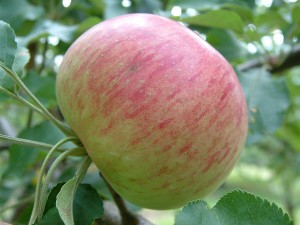
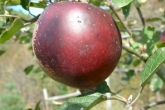
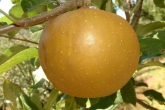
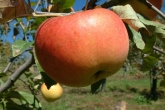
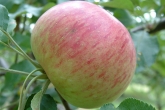








Hi,
I grew up on a farm about a mile from the Wolf River. Legend was the original apple tree was located on our farm. There was a local history book with a picture of the tree and I can picture it in my mind where it was located. I remember climbing those trees and picking up the apples. My grandmother taught me to make pies. Later that area became a pasture for my horses and they ate the fallen apples.
Life has taken me to NE Arizona. Recently I met a lady who was starting an orchard of fruit trees. To my surprise, she said the Wolf River apple tree is perfectly suited to this environment. She suggested I get a graft from the original tree because my brother now owns the property. Unfortunately, the tree had died and my brother had removed it. The other trees on the property are not true Wolf River trees. They produce an apple that is similar but smaller than the apples that came from that tree. We moved to Fremont in 1977 and that tree produced until the mid 80s. In the late 80s and early 90s when it became a pasture, the tree was not producing as strongly so I didn’t worry the horses would overeat.
The information that this was the original tree came from an old neighbor who had grown up in the area. He was the local historian and took the picture of the tree on our farm. Just thought I would finish the story. I really enjoyed those pies and applesauce we made. Eventually, I plan to start a Wolf River apple orchard on our 80 acres here!
Hi Trish,
Yours is a marvelous story about one of America’s greatest heritage apples. From a chance seedling planted on the banks of the Wolf River in Fremont Co., Wisconsin, Wolf River rapidly became a prized apple, eagerly sought by many and quickly disseminated throughout the country. Orchardists, commercial growers and small homeowners alike came to appreciate the quality and flavor of Wolf River, especially when used in making world-class applesauce and apple butter.
Historically, the apple was closely integrated into the social fabric of many small communities when families, clans and gatherings of friends and neighbors would come together in early fall to harvest their Wolf River apples and spend time together turning their bountiful harvest into smooth and creamy apple butter. These communal gatherings still take place in many regions across the country and we have had the pleasure to attend a couple of these social events ourselves. During these day-long assemblies, the collected applesauce is slowly cooked over open fires in large copper or cast iron kettles where the applesauce is gently cooked-down into warm and sweet apple butter. At these congregations everyone is expected to contribute to the process by slowly and continuously hand-stirring the thick pulp to prevent it from sticking and burning. At the end of the day, all are rewarded for their patience and dedication by receiving a couple of quarts of the deliciously sweet apple butter to take home and enjoy for themselves!
Thank you very much for sharing your experiences with this classic American apple. It has indeed been a great pleasure to hear your story and your family’s connection with this great apple. Wolf River is one of our most popular and best-selling varieties and will probably remain so forever! Good luck and best wishes as you begin your personal project to establish a new orchard of Wolf River apple trees.
Ron Joyner
Ron,
You didn’t say where you are from. I would like to buy some Wolf River apples.
Robert
We’re very sorry, Robert, but we did not produce any Wolf River apples this season. In fact, no one in this region had any significant quantities of Wolf River apples this year. It was very disappointing as this variety is extremely popular and always in high demand by our customers. We regret we are unable to help with your request. Thanks for your interest.
We had a wolf river apple tree on our property near Denmark. They were huge! The new owners of our old house lost half of the tree about 10 years ago when the age and weight of the apples split the tree in half. Found an orchard near Suring that sells saplings. Tried and failed to grow them( long story)
Hello, from Clay Co., NC!
I am a fellow apple-lover and would-be orchardist, struggling with apple diseases and pests. My Wolf River tree produced its first apple this season, after about 8 years’ growth. Good to know its disease resistance is better than the other old-time varieties I have. My success has been thwarted by 2 bad falls (1 broken arm, 1 broken wrist), borers, fire blight, late-season freezes, a bear, root rot and other insects. My trees came from Mr. Jim Lawson, whose work in preserving these fine, heirloom varieties was invaluable. I have about 25 young trees, with only a few of the same variety. I would greatly appreciate advice of any sort (especially sources of reference material). It truly is a labor of love to try to grow apples-I refuse to give up! Thank you.
What zone can these Wolf River trees grow in. I’m in zone 3B and have a two year old but we have not had a real cold winter yet how many years until I see some fruit. The tree is already 12 feet tall.